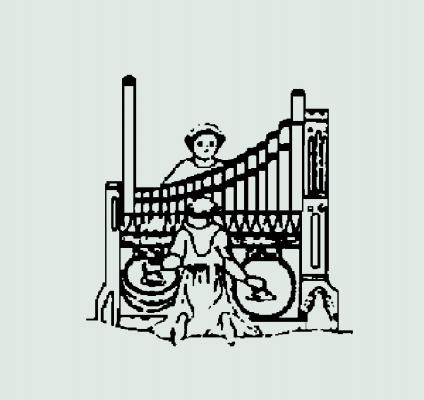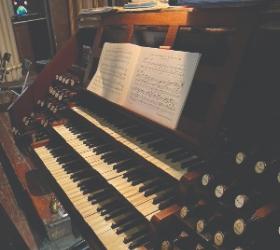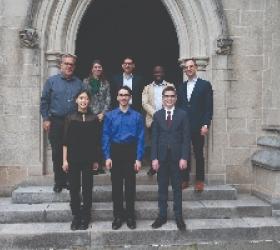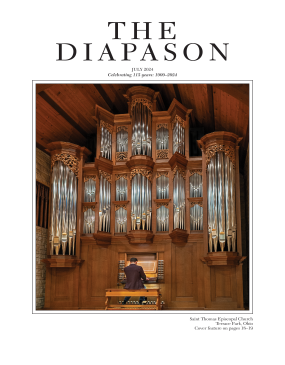
Cover
Noack Organ Company, Inc., Georgetown, Massachusetts
St. Paul Seminary School of Divinity of the University of St. Thomas,
St. Paul, Minnesota
Opus 136
The new organ in St. Mary's Chapel at St. Paul Seminary was not only to be a fitting instrument for the seminarians' services, but also provide a good example of a fine organ for the parishes which they some day might serve. Perhaps it was a blessing that the planning process took well over twenty years, allowing ideas to ferment, dreams to be molded into reality and, we hope, finding of a valid solution. Our files go back to 1979 and a letter from Charles Fisk to Elizabeth Stodola with a proposal for an organ still assuming the old balcony. Later reports included Frank Kacmarcik's stunning renovation of the chapel as eventually realized. In 1989 I had the pleasure of attending early planning sessions with Sue Seid-Martin, as well as with David Jenkins, with whom we were privileged to work through many stages to the final conclusion.
To serve a seminary chapel the organ has to address a few special requirements. It must, of course, to be able to lead congregational and choir singing and perform a wide range of organ literature suitable for this setting. In addition, we realized that a congregation of seminarians needs a fuller sound on the one hand and more than just a quiet flute stop for the accompaniment of chant on the other. All of this we aimed to accomplish with no more stops than necessary, making an example of good stewardship. The organ is not a copy of any particular historic style, although some kinship with baroque German organs and nineteenth-century New England organs can be found.
The case front was originally to have 16-foot-tall front pipes, but with a somewhat more disciplined approach 8-foot diapasons have been provided for both the Great and Pedal fronts in the upper part of the instrument. Since the organ visually serves as the termination of the (liturgical) east end of the chapel, this de facto reredos needed to be quite tall; at 271?2 feet the organ is considerably taller than necessary to accommodate the pipework. The Swell division is housed in the lower part of the organ, hidden behind a very simple, delicate grill of the same design as the pipe shades.
The pipework is made from 20 percent and 70 percent tin, except for the ash bass pipes. A wedge-shaped bellows provides wind that is just flexible enough to add a human quality to the sound. A slightly unequal temperament (Valotti) was used, rendering the simpler keys (with fewer flats or sharps) more pleasant than equal temperament.
I join my fellow organ builders at The Noack Organ Co., Inc., in expressing our gratitude for the opportunity to build this organ. In addition to the individuals already mentioned we would like to thank Tom Fisch, Fr. Phillip Rask, Fr. Charles Froehle, Thomas Keefe, James Callahan, James Frazier, Delores Bruch Cannon, and Richard Proulx, who all contributed to the success of this project in their own valuable way. We hope this organ will bring joy and peace to the worshipers in St. Mary Chapel for many years to come.
--Fritz Noack
Notes from the liturgical music director
When I came to work on the staff of The St. Paul Seminary School of Divinity in 1988, there was a spirit of excitement in the air, and anticipation of great changes and improvements coming to the seminary. The new residence and administration building were already going up and preparations were underway to renovate St. Mary's Chapel. While the original basilica form of the building would be recovered and its inherent beauty enhanced, the chapel would at the same time be reconfigured to conform to the requirements of Vatican II worship.
There was no question from the onset of the renovation that the installation of a new pipe organ of quality was essential to supporting the liturgy at the seminary. According to the vision of music director Ms. Sue Seid-Martin and others, the new instrument would not only serve the seminary's daily worship, but would highlight the formative influence of liturgical music in a school that trains future ministers. The instrument also would have a diocesan and regional impact by modeling the central and traditional role of the organ in the musical liturgy of the Roman Catholic Church.
Father Charles Froehle, then rector of the seminary, appointed an organ committee to begin work that would lead to the selection of an organ builder. Ms. Sue Seid-Martin was chairperson. I also served on the committee along with Dr. James Callahan, of the then College of St. Thomas, and James Frazier, then the music director for the Archdiocese. We worked closely with Dr. Thomas Fisch, chair of the chapel renovation committee, Brother Frank Kacmarcik, liturgical designer, and Mr. Richard Clements and Mr. Clifford Olson, who oversaw the building project. After consulting with a few builders, we were pleased to recommend Mr. Fritz Noack as our choice.
We already were acquainted with Noack as a builder who had a long record of producing consistently high quality instruments. Important to us also was the fact that he already had collaborated successfully with Kacmarcik during the installation of the new organ for the College of St. Benedict's renovated chapel. In our initial consultations Noack proved willing and able to work with the sensitive aspects of architectural considerations as well as with the tonal design. The organ was conceived not only to serve the active liturgical life of the seminary but also to form a visual "terminus" on the (liturgical) east end of the space. Noack builds instruments that are beautiful to both the eye and the ear. We were confident he could produce an authentically crafted instrument for St. Mary's Chapel that would enhance the whole "environment" for worship--both sonically and visually. He understood our unique tonal demands for an instrument that could support the singing of sonorous male voices in a not-too-large but reverberant space. He also understood our need for a flexible instrument that could be used to accompany a range of vocal and instrumental forces: from solo voices and solo instruments, to small groups, choirs, and instrumental ensembles, as well as worshiping assemblies from fifteen people to two hundred or more.
After our original consultation process led to concrete plans for the Noack instrument, the project was put on hold for a few years. Now, thanks to the leadership of Father Phillip Rask, Mr. Thomas Keefe, Monsignor William Baumgaertner, Dr. Fisch, and to the generosity of Mr. Cyril Rotter and others, the project has been completed. The dedication of the new organ is a wonderful occasion to renew and celebrate the vision and spirit created by planning that began over twenty years ago. The organ, dedicated to the glory of God, will serve the liturgical life of the seminary in a continuation and renewal of the long tradition of excellence in worship at The St. Paul Seminary.
--David P. Jenkins
GREAT
16' Bourdon
8' Diapason
8' Chimney Flute
4' Octave
22/3' Twelfth
13/5' Seventeenth
11/3' Mixture IV
8' Trumpet
SWELL
8' Viola
8' Stopt Flute
4' Principal
4' Recorder
2' Octave
11/3' Quinte
Cornet III (from tenor f)
8' Cremona
PEDAL
16' Stopt Bass
8' Octave
8' Gedact
4' Choral Bass
16' Trombone
Mechanical action throughout
Manual/pedal compass: 58/32
GREAT
16' Bourdon
8' Diapason
8' Chimney Flute
4' Octave
22/3' Twelfth
13/5' Seventeenth
11/3' Mixture IV
8' Trumpet
SWELL
8' Viola
8' Stopt Flute
4' Principal
4' Recorder
2' Octave
11/3' Quinte
Cornet III (from tenor f)
8' Cremona
PEDAL
16' Stopt Bass
8' Octave
8' Gedact
4' Choral Bass
16' Trombone
Mechanical action throughout
Manual/pedal compass: 58/32




